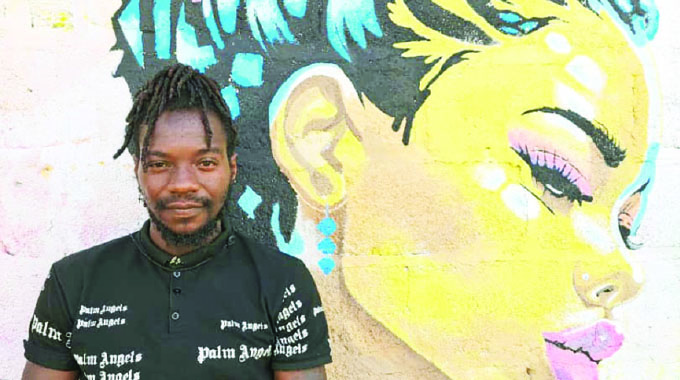Tracing modern art in Zim
Stephen Garan’anga Visual Art
The territories around the Zambezi River were the destination for many European adventurers, travellers, fortune-seekers and hunters since the early 19th century. Some of these early Europeans were also artists. Perhaps the most prolific was Thomas Baines (1820-1875), who was at one time part of David Livingston’s Zambezi expedition of 1859 and who later led a part of prospectors and concessionaires through the country.
Although Baines was an adventurer, fully absorbed by his travels and trade deals, he still followed the call of art, devoting considerable time and energy to sketching and sights of interest.
His many paintings and sketches are an important source of historical information on the region’s mid-19th century people and traditions now lost though they are not necessarily scientifically accurate.
As appreciated by Livingston, their value lies as pieces of art. The first modern style paintings made on African soil was around the Zambezi River.
Few other European travellers followed the same artistic call and productivity as Baines.
Alice Balfour, who came to Rhodesia as a tourist in the early 1890s, left pencil sketches and several water colour landscape paintings that captured the essence of untamed Africa in the first years of its colonisation.
The Czech/Austrian traveller Emil Holub carefully drew people’s customs and traditional arts and crafts of the communities living around the Zambezi in the 1870s and 1880s.
However, these artists were nothing more than chroniclers of their times and their actual works have generally been forgotten. The fact is that they introduced into central Southern Africa the western tradition of painting.
Later, when the Rhodesian settlers’ society stabilised, this became the predominant style, if not the norm of all aspiring artists of these territories whose efforts were inspired by the many local amateur art societies that were formed.
With an increasing number of Europeans traveling through the territories around the Zambezi, interest in the collection of local African handicrafts increased.
Traditional art and crafts were manufactured not only for own use but primarily for sale to passing travellers. One of the earliest attempts to encourage and formalise this trade was in the early 1890s in Barotseland, a territory north-west of the Zambezi and now part of Zambia.
Here the local missionaries organised competitions for local Africans. The region’s prolific curio trade had begun; wood and horn carvings, pots and other clay objects and other paintings quickly appeared at places like railway stations, tourist spots, and crafts markets frequented by foreign visitors.
Although only curios, some of these were undoubtedly works of art by our present standards. This development was not unique but mirrors the same pattern that happened across colonised Africa. The Europeans’ fascination with exotic art created a market niche for curios that the local African people quickly filled.
It was not until after World War II that some European missionaries pioneered the first “serious” art lessons in their missions. They brought their modern art to the local Africans and established the first workshops were their students created fine art works.
Two leading figures in the then Southern Rhodesia were Swiss Catholic Hans Groeber and Scottish Protestant Canon Ned Paterson.
The two founded their own art workshop at newly established mission stations. Groeber established his at Serima, 50 kilometres north of the Great Zimbabwe and Paterson at Cyrene near Bulawayo, which was the country’s biggest city.
For almost a quarter of a century until the 1960s, they taught the native Africans the basics of woodworking, stone carving and painting.
Their students were soon successfully exhibiting across Rhodesia and the United Kingdom.
Although the missionaries’ aims were basically liturgical, artistic education and the establishment of modern African artistic creativity was secondary. They are known as the founding-fathers of a new modern African art. The subjects at that time were essentially religious and often biblical depictions, but still with their first major exhibition held in London in 1949, modern African art in then Rhodesia was born.
Drawing on a western African tradition, Groeber’s Serima mission became renowned for imparting woodcarving skills.
These Rhodesian African artists brought in their own style, producing high quality sculptures that found their way into many churches and chapels across the country.
In addition they created a unique mission church, carved in their distinctive style. Sadly, it now lies almost idle, unnoticed by travellers in the middle of the African bush some 30 kilometres by unpaved road from the main highway connecting Harare with neighbouring South Africa.
Paterson’s Cyrene Mission with its smaller and beautifully painted chapel developed a variety of mediums untainted by other traditions, so creating a distinctive style of its very own.
Being adjacent to a large secondary school, the chapel remains a living centre of worship and artistic inspiration.
Groeber and Paterson were not only the Europeans who were trying to promote the creation of a local African artistic tradition.
Similar efforts were started in Lusaka, the capital of then Northern Rhodesia. In the mid 1940s, an English painter Ernest Knight, established an art school on the premises of the local African hospital.
Here painting by the patients was part of medical treatment. It was a successful, though sadly short-lived experiment.
Many of the best works by patients-turned-artists toured the British Commonwealth in the 1950s, probably without the knowledge of the artists who had been forgotten.
In the late 1950s, the first art initiative created independently by a local African artist was born.
In eastern Southern Rhodesia Joram Mariga, who in 1958 was working as a labourer repairing roads near the Mozambique border, realised that the stones they were using to fill potholes could be put to a better use.
He and his colleagues began producing perfect copies of historical stone containers, small statues and utility objects. Initially they gave them away as gifts to friends and passers-by.
They were not trying to produce artistic items but as good stonemasons, they quickly experimented and perfected a new artistic tradition.
Without doubt, Mariga’s group can be cited as the earliest, local African artistic initiative in the two Rhodesias. They represented the beginning of a bigger artistic tradition, which would later put these countries firmly on the art map of the world.
With an increasing number of Europeans living in both Rhodesias, an interest in visual arts developed.
In 1943, money was bequeathed to establish the first art gallery in Southern Rhodesia, primarily with the aim of promoting Western art amongst the local European population. It took sometime to be built but its collections were artworks of leading classical and contemporary European artists, thanks to several wealthy benefactors.
Rhodesia’s sudden economic prosperity in the 1950s provided added stimulus to the blossoming of artistic interest, as was the white population’s need to find cultural expression at a time when they were becoming increasingly marginalised in world opinion for their practice of racial segregation.
Several leading cultural institutions were opened that would not have been supported previously. One of these was the National Gallery in Southern Rhodesia’s capital Salisbury now Harare the capital of Zimbabwe. This was envisaged as a celebration of Western art as well as a centre for art education.
The Queen Mother opened the National Gallery in 1957 and its establishment was the major impulse giving birth to modern art in both Rhodesias.





Comments